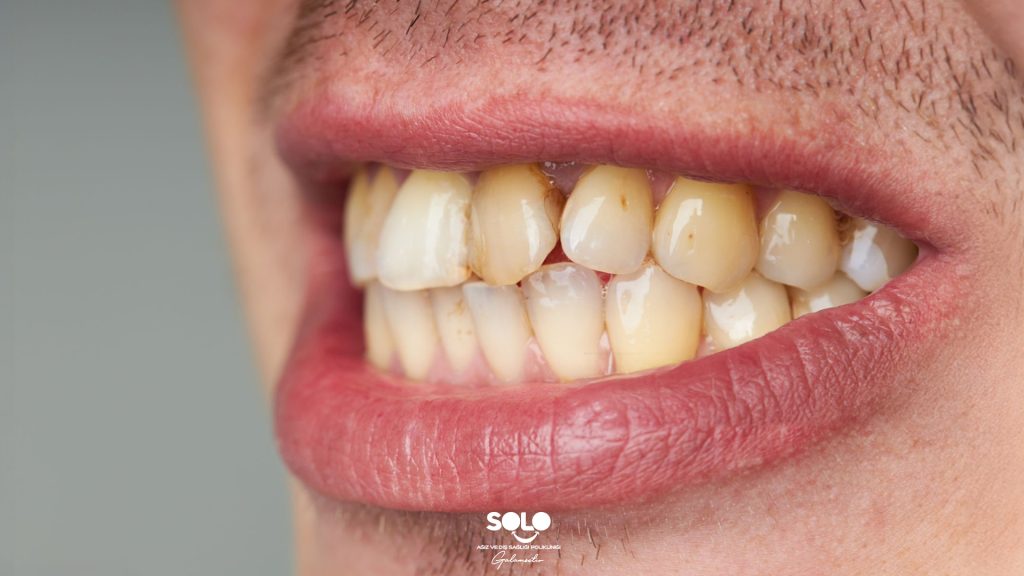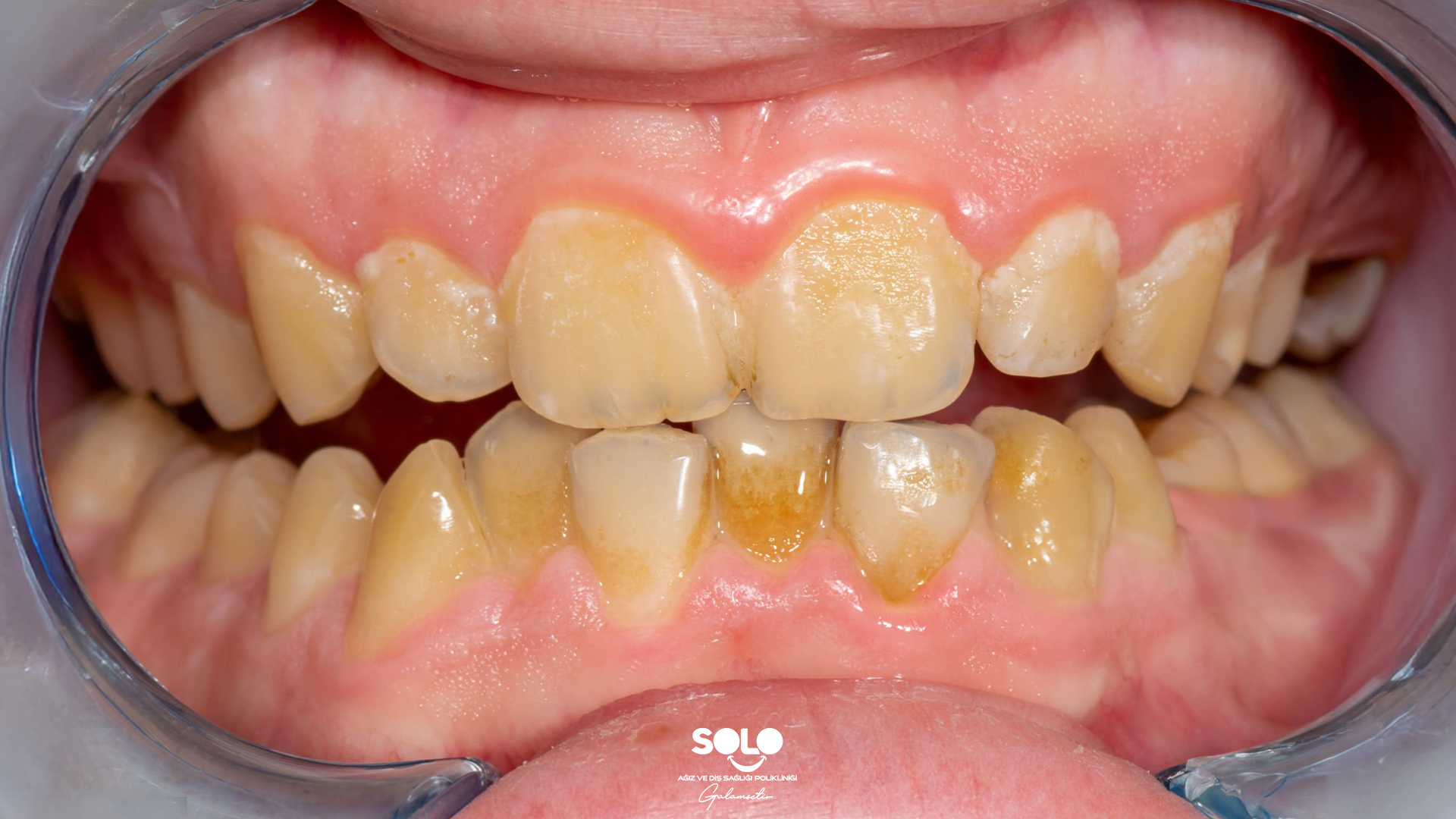Causes of Yellowing Teeth
Have you ever noticed your smile isn’t as bright as it used to be when you looked in the mirror? Perhaps that change in tone suddenly caught your eye as you sipped your morning coffee or smiled in a photo. You might have thought, “It seems like my teeth have turned a little yellower.” Don’t worry, you’re not alone. This change in tooth color over time is a natural process experienced by almost everyone.
In fact, yellowing of teeth doesn’t occur overnight; it often develops gradually over the years. The coffee, tea, and even certain fruits we drink throughout the day are the unsung heroes of this color change. Moreover, not only our dietary habits but also our age, the medications we use, and even our genetic makeup play a role in this process.
But here’s the good news: Yellowing teeth isn’t fate. With proper care, careful habits, and a few small changes, it’s possible to make our smiles sparkle again. In this article, we’ll discuss why our teeth yellow, the underlying causes, and ways to maintain their natural whiteness.
If you’re ready, grab a cup of coffee yes, that famous culprit! Let’s explore this topic step by step in a friendly conversation.
Why Do Teeth Yellow?
Teeth yellowing is a natural process that we all experience over time, without even realizing it. The coffee, tea, cigarettes, and certain foods we consume throughout the day gradually change the color of our tooth enamel. Sometimes, due to genetic factors or aging, the natural whiteness of our teeth gives way to a yellowish hue. This condition is often due to the flow of life, not poor oral hygiene. However, the good news is that with proper cleaning habits and regular dental checkups, it’s possible to slow this process down and even restore the natural shine of our teeth. Yellowing isn’t fate; it’s a detail that can be changed with a little care.

Our Teeth May Yellow Over Time
In fact, the yellowing of our teeth over time is one of the most natural manifestations of aging. As the years go by, the layer beneath the enamel, called “dentin,” gradually becomes more visible. Dentin is naturally slightly yellow, and as the enamel thins, this color becomes more visible. Just like graying hair, this change in tooth color is a natural part of life. But the good news is that with regular cleanings, a conscious diet, and good oral care, it’s possible to slow this process considerably and even maintain the vibrant and healthy appearance of our teeth for many years.
Discoloring Beverages Like Tea and Coffee
Are you one of those people who can’t start the day without coffee? Or do you reach for it every time you take a break? In fact, these pleasurable habits are one of the causes of yellowing teeth.
Beverages like coffee, tea, cola, and red wine contain natural compounds called “tannins.” These tannins adhere to tooth enamel and, over time, form a thin layer of discoloration on the surface of your teeth. While it may not be noticeable at first, over time, the bright whiteness of your teeth gives way to a duller, yellowish hue.
But don’t worry, it’s possible to reduce this effect with simple precautions. For example, drinking coffee or tea through a straw and swishing your mouth with water afterward can significantly prevent stains from adhering to tooth enamel. So, you can protect your teeth without giving up your favorite beverages; you just need to be a little more careful.
Smoking and Tobacco Use Can Cause Yellowing of Teeth
Unfortunately, one of the biggest culprits in yellowing teeth is cigarettes. The nicotine and tar in tobacco penetrate tooth enamel so deeply that, over time, those white tones give way to permanent stains that turn yellow or even brown. And it’s not just about aesthetics; smoking weakens gums, causes bad breath, and seriously negatively impacts overall oral health.
In short, smoking not only tarnishes your breath but also the radiance of your smile. The moment you quit, you’ll notice that even your teeth can breathe again.

Pay Attention to Oral Hygiene
The secret to preserving the color of our teeth lies in those seemingly simple daily cleaning habits. Brushing twice a day, flossing, and occasionally using mouthwash… These seemingly small steps make a big difference in the long run. Tiny food particles and plaque left on the teeth harden over time, forming the yellowish layer we call “tartar.” Unfortunately, this layer cannot be removed with regular brushing and causes teeth to yellow.
A professional cleaning performed by a dentist at least once a year can truly breathe new life into your teeth. Remember, a bright smile starts with regular care and a little care, not expensive products.
Pay Attention to Oral Hygiene
The secret to preserving the color of our teeth lies in those seemingly simple daily cleaning habits. Brushing twice a day, flossing, and occasionally using mouthwash… These seemingly small steps make a big difference in the long run. Tiny food particles and plaque left on the teeth harden over time, forming the yellowish layer we call “tartar.” Unfortunately, this layer cannot be removed with regular brushing and causes teeth to yellow.
A professional cleaning performed by a dentist at least once a year can truly breathe new life into your teeth. Remember, a bright smile starts with regular care and a little care, not expensive products.

Excess Fluoride
Fluoride is known as a friend to our teeth because it strengthens tooth enamel and helps prevent cavities. Unfortunately, too much of it can sometimes have adverse effects. Excessive fluoride intake, especially during childhood for example, drinking heavily fluoridated water or using excessive amounts of fluoride toothpaste can lead to the formation of white or yellow stains on teeth, known as fluorosis.
This condition usually only causes yellowing of the teeth and doesn’t pose a significant health risk. However, it’s important to be careful, as it can affect the natural appearance of your teeth.
How to Treat Yellowing Teeth
While tooth discoloration can’t be completely prevented, it’s possible to slow it down with simple habits.
First and foremost, brush your teeth at least twice a day and rinse your mouth with water after consuming colored beverages. Drinking coffee, tea, and cola through a straw also reduces the risk of stains clinging to your teeth. Quitting or at least reducing smoking protects both your teeth’s color and your overall oral health. Furthermore, visiting your dentist for a professional cleaning once a year can restore your teeth’s natural whiteness.
A white smile isn’t a miracle, but achievable through regular and conscientious care habits.

